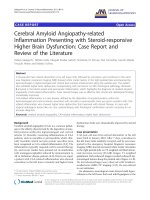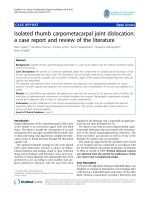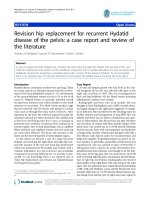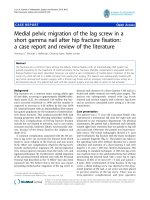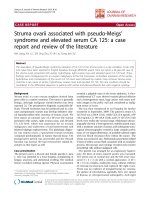Clinicopathologic characteristics and prognostic factors for primary spinal epidural lymphoma: Report on 36 Chinese patients and review of the literature
Bạn đang xem bản rút gọn của tài liệu. Xem và tải ngay bản đầy đủ của tài liệu tại đây (665.55 KB, 6 trang )
Xiong et al. BMC Cancer (2017) 17:131
DOI 10.1186/s12885-017-3093-z
RESEARCH ARTICLE
Open Access
Clinicopathologic characteristics and
prognostic factors for primary spinal
epidural lymphoma: report on 36 Chinese
patients and review of the literature
Le Xiong1†, Ling-Min Liao2†, Jian-Wu Ding1, Zhi-Lin Zhang3, An-Wen Liu1* and Long Huang1*
Abstract
Background: Due to the uncommon nature of primary spinal epidural lymphomas (PSELs), there has been little
research looking at prognostic indicators for the tumor. To our knowledge, this is the largest study to evaluate
possible clinical and pathologic prognostic factors in PSEL patients.
Methods: We retrospectively reviewed 130 cases of PSEL, including 36 Chinese patients and 94 published case reports
from 1985 to 2015. Patient treatment regimens included surgery (S; n = 119), surgery followed by chemotherapy
(S + CT; n = 25), surgery followed by radiotherapy (S + RT; n = 26), and surgery followed by chemotherapy and
radiotherapy (S + CT + RT; n = 50).
Results: Review of the most recent case follow-up data (time varied) found 51 patients (47%) alive and tumorfree, 10 patients (9%) alive with tumor present, and 47 patients (44%) deceased. The 3-year overall survival (OS)
and disease-free survival (DFS) rates were 81.1% and 46.3%, respectively. Favorable prognostic factors found by
univariate analysis were female sex, B-cell lymphoma diagnosis, cervical spine location, and combined modality
treatment. Furthermore, multivariate analysis revealed that thoracic spine location (HR = 4.629, 95% CI = [1.911,
31.667], P = 0.042 for OS) and the lack of combined modality treatment (HR = 12.697, 95% CI = [2.664, 48.612],
P < 0.0001 for DFS) were associated with poor survival in PSEL patients.
Conclusions: PSEL demonstrates specific clinical features and is associated with a relatively good prognosis.
Thoracic spine location is a significant poor prognostic factor, and combined modality treatment is associated
with improved disease-free survival, but not overall survival.
Keywords: Primary spinal epidural lymphomas, Treatment, Prognosis
Background
Primary spinal epidural lymphomas (PSELs) are very
rare, and relatively few such tumors have been reported
in the literature. Although PSEL accounts for 10% of all
epidural spinal tumors [1], the epidural location is a rare
site of presentation for lymphomas, characterizing only
0.1 to 3.3% of all lymphomas [2, 3]. Due to the rarity of
the condition, it is difficult to enroll a sufficient number
* Correspondence: ;
†
Equal contributors
1
Department of Oncology, The Second Affiliated Hospital of Nanchang
University, 1 Minde Road, Nanchang, Jiangxi, China
Full list of author information is available at the end of the article
of patients with PSEL to adequately evaluate possible
factors associated with survival. The largest series to
date, reported by Monnard et al. [4], identified 52 patients over 20 years (1982–2002). However, the limited
number of patients and the long time span have made it
difficult to establish the disease parameters, such as the
natural history of the disease, prognostic indicators,
treatment techniques employed, and survival rates. For
this study, we identified only retrospective studies, which
included reports on relatively small numbers of patients
or single case reports. The goal of this study was to help
identify the clinical profile, treatment outcomes, and significant prognostic indicators in PSEL patients.
© The Author(s). 2017 Open Access This article is distributed under the terms of the Creative Commons Attribution 4.0
International License ( which permits unrestricted use, distribution, and
reproduction in any medium, provided you give appropriate credit to the original author(s) and the source, provide a link to
the Creative Commons license, and indicate if changes were made. The Creative Commons Public Domain Dedication waiver
( applies to the data made available in this article, unless otherwise stated.
Xiong et al. BMC Cancer (2017) 17:131
Methods
Patient characteristics
A total of 130 PSEL cases were retrospectively
reviewed, including 36 Chinese patients and 94 published case reports from 1985 to 2015. Patients were selected if there was a conclusive histopathologic
diagnosis of PSEL with complete clinical pathology, and
there was no history of previous malignant disease or a
second primary tumor. The 130 patients included 76
men (58%), 44 women (34%) and 10 unknown (8%), for
a known male-to-female ratio of 1.73. The median age
was 45 years (range, 3–80 years), and median follow-up
was 32 months (range, 1–149 months). Clinical and
pathological variables analyzed included patient age
and gender; tumor stage, differentiation, location, and
range; and treatment modalities employed (Table 1).
Page 2 of 6
Table 1 Analysis of clinicopathological factors for chinese
patients and report cases
Chinese patients
n = 36 (%)
n = 94 (%)
Median age (year)
26
48
/
Median survival (month)
12
27
/
Male
26 (74.3)
50 (60.0)
Female
9 (25.7)
34 (40.0)
B cell lymphoma
25 (78.1)
69 (74.2)
T cell lymphoma
6 (18.8)
7 (7.5)
Burkitt’s lymphoma
1 (3.1)
17 (18.3)
Gender
0.640
Pathology
0.035
Stage
Treatment
Most patients diagnosed with stage IE–IIE PSEL had
been treated with tumorectomy (n = 121, 93%); the rest
had surgical contraindications or refused surgery. The
primary treatment of patients consisted primarily of surgery. Individualized postoperative treatment consisted of
radiation therapy alone (n = 26, 21%), chemotherapy
alone (n = 20, 25%), or concurrent chemoradiation therapy (n = 41, 49%). The median radiotherapy dose was
40 Gy (range, 20–50 Gy), and the total dose was administered over 3–5 weeks. Twenty-eight patients (34%) had
only focal treatment, whereas the remaining 55 (66%) received more than focal treatment. Eight-two patients
(63%) had chemotherapy, which consisted of cyclophosphamide, doxorubicin, vincristine, and prednisone
in the majority of patients; methotrexate, leucovorin,
etoposide, and bleomycin were also used in some
patients. Generally, 4–8 cycles of chemotherapy were
administered at 3-week intervals. Methotrexate was
administered in 21 patients (26%).
Report cases
P value
Characteristics
I
13 (76.5)
44 (81.5)
II-IV
4 (23.5)
10 (18.5)
1–2 spine
8 (22.9)
25 (50.0)
3–4 spine
21 (60.0)
14 (28.0)
≥ 5 spine
6 (17.1)
11 (22.0)
Yes
5 (14.3)
45 (48.9)
No
30 (85.7)
47 (51.1)
Yes
17 (56.7)
57 (62.0)
No
18 (43.3)
35 (38.0)
Yes
33 (94.3)
85 (92.4)
No
2 (5.7)
7 (7.6)
Yes
15 (42.9)
3 (3.3)
No
20 (57.1)
89 (96.7)
0.651
Range
0.010
S + RT + CT
<0.001
S + CT
0.172
S
0.710
S only
<0.001
S surgery, CT chemotherapy, RT radiotherapy, Bold indicates significant values
Statistical analysis
The Kaplan–Meier method and log-rank tests were
used to determine overall survival (OS) and disease-free
survival (DFS). Independent prognostic factors for OS
and DFS were identified using the Cox proportional
hazards model. SPSS software (version 13.0, SPSS Inc.,
Chicago, IL) was used for all statistical analyses, and P
values < 0.05 were considered statistically significant.
Results
Clinical features
The median patient age was 45 years (range, 3–80 years).
In three of the 130 patients (2%), PSEL was detected during a routine examination. Alternatively, 112 of the patients (86%) presented with neck, back, lumbosacral, or
limb pain, or with cord compression syndrome. For 15
cases (12%) reviewed from published case reports, the details of presentation were not provided. The most commonly reported symptoms were motor weakness or
hypoesthesia (62%), back pain (59%), lumbosacral pain
(32%), limb pain (28%), neck pain (9%), bowel dysfunction
(23%), bladder dysfunction (19%), and low-grade fevers
(2%). The time from the first symptom to diagnosis varied
from 3 days to 5 years. Patient characteristics are presented in Additional file 1: Table S1 and Additional file 2:
Table S2.
Pathologic features
Case reviews showed tumor pathologies of B-cell lymphoma (n = 88, 76%), T-cell lymphoma (n = 13, 11%), or
Burkitt’s lymphoma (n = 15, 13%). Subsets of cases were
Xiong et al. BMC Cancer (2017) 17:131
Page 3 of 6
identified with tumor cells showing the strong expression of leukocyte common antigen (19/19, 100%) or the
absence of CD20 expression (21/27, 78%). Additional
immunohistochemical assays performed in a subset of
the cases included detection of CD3 (8/13, 62%), CD45
(6/9, 67%), and CD79 (7/7, 100%). See Additional file 1:
Table S1 and Additional file 2: Table S2.
Table 2 The 3-year' OS and DFS rates associated with primary
spinal epidural lymphomas patients
Survival
Gender
The median follow-up period was 32 months. Relapses
were observed in 21 patients (19%) after a median period
of 12 months, primarily in the central nervous system
(n = 11), lymph nodes (n = 4), chest or abdomen (n = 5),
and liver (n = 2). The 3-year OS and DFS were 81.1 and
46.3%, respectively.
Prognostic factors
In order to identify potential prognostic factors associated with survival in PSEL patients, various clinicopathologic variables were evaluated (Table 2). Using univariate
analysis, gender, pathological pattern, tumor differentiation, tumor location, and tumor range were found to be
associated with OS (P < 0.05), but not with DFS. The 3year OS rates for males and females were 60.3% and
100% (P = 0.002), respectively (Fig. 1a). The 3-year OS
rates for thoracic, cervical, and lumbosacral spine locations were 64.1, 94.3, and 100% (P = 0.005), respectively
(Fig. 1b). The 3-year OS rates for B-cell, T-cell, and
Burkitt’s lymphoma were 87.7, 83.3, and 29.5% (P =
0.002), respectively (Fig. 1c). In terms of treatments received, the 3-year DFS rate for patients receiving S alone
was 23.3% (P = 0.004, compared with the other treatment
groups; Fig. 2), while patients receiving S + RT + CT had a
3-year DFS rate of 49.6% (P = 0.031, compared with the
other treatment groups, Fig. 3); patients receiving S + CT
had a 3-year DFS rate of 50.4% (P = 0.042, compared with
the other treatment groups; Fig. 4). For the same patient
treatment groups, the 3-year OS rates were 80.0, 81.7, and
79.5%, respectively; these did not significantly vary (P >
0.05 for all; Figs. 5, 6, and 7). Multivariate analysis revealed
that thoracic spine location (HR = 4.629, 95% CI = [1.911,
31.667], P = 0.042 for OS) and the lack of combined modality treatment (HR = 12.697, 95% CI = [2.664, 48.612], P
< 0.0001 for DFS) were associated with poor survival in
PSEL patients.
Characteristics
Case
(n)
3 year's
< 45
64
54.8
≥ 45
64
41.8
Male
76
47.7
Female
44
47.7
88
47.6
DFS(%)
3 year's
P
OS
P
Age (year)
70.5
0.413
90.9
0.181
60.3
0.608
100.0
0.002
Pathology
B cell lymphoma
T cell lymphoma
13
53.6
Burkitt’s lymphoma
15
25.0
19
54.5
87.7
83.3
0.081
29.5
0.002
Differentiate
Poor
Moderate
12
50.5
High
8
60.0
I
58
36.7
II-IV
14
77.4
74.1
68.2
0.309
100.0
0.035
Stage
75.1
0.084
/
0.198
Location
Cervical
14
74.0
94.3
Thoracic
69
35.7
64.1
Lumbosacral
25
57.4
Sacral
3
/
17
36.4
100.0
0.089
/
0.005
Range
1–2 spine
3–4 spine
33
46.7
≥ 5 spine
18
41.2
Yes
49
49.6
No
56
38.0
86.2
81.9
0.698
74.4
0.013
S + RT + CT
81.7
0.031
81.4
0.042
84.3
0.955
S + CT
Yes
65
50.4
No
40
41.4
Yes
96
46.8
No
9
47.6
79.5
0.984
S
80.0
0.994
100.0
0.004
81.6
0.592
S only
Discussion
With a study cohort of 130 patients treated over a 30year period, the current study represents the largest one
to focus on PSEL. Prior to this, the largest one reported
on only 52 patients, and predated modern radiotherapy
and chemotherapy protocols.
The origin of primary spinal epidural lymphomas
(PSEL) remains controversial. It is known that lymphoma
Yes
5
23.3
No
100
75.6
80.0
0.437
S surgery, CT chemotherapy, RT radiotherapy, Bold indicates significant values
may arise anywhere lymphatic tissue is found. However,
whether there is lymphoid tissue in the epidural space has
been debated [5, 6]. Rubinstein was the first to
Xiong et al. BMC Cancer (2017) 17:131
Page 4 of 6
Fig. 1 Kaplan–Meier survival curves for clinicopathologic factors of patients with primary spinal epidural lymphomas. a Survival curves for OS in
relation to gender in primary spinal epidural lymphomas as indicated. b Survival curves for OS in relation to tumor location. c Survival curves for
OS associated with different pathological factors as indicated. Favorable prognostic factors in primary spinal epidural lymphoma patients were
female sex, B-cell lymphoma type, and cervical spine location
demonstrate the presence of lymphoid cells in epidural
tissue, and he introduced the theory of antigenic stimulation with a transformation cascade [7]. Some have suggested that PSEL may originate from either paraspinal,
spinal, or retroperitoneal tissues, accessing the epidural
space via the interspinal foramina [8, 9]. However, the occurrence of lymphoma in this location indicates that
lymphoid precursor cells are present in the space. Metastasis is the most common sacral malignancy, whereas
chordoma in the most common primary sacral tumor
[10]. PSELs represent 10% of epidural spinal tumors, but
the epidural location is a rare presenting site for lymphomas, being seen in only 0.1 to 3.3% of all lymphomas.
When lymphoma has been found in the spine, it has been
reported most often in the lumbar or lower dorsal area
[11]. However, in this study, we found the thoracic spine
to be the most common site (62%) for lymphoma.
The most common presenting symptoms reported in
the literature have included lower limb weakness, localized back pain, and bladder dysfunction [8, 9]. However,
in this study, the most common symptoms seen were
motor weakness or hypoesthesia (62%), back pain (59%),
lumbosacral pain (32%), limb pain (28%), neck pain
(9%), bowel dysfunction (23%), bladder dysfunction
(19%), and low-grade fevers (2%). It is noteworthy that
most patients presented with persistent back pain for
considerably long periods of time prior to diagnosis.
Therefore, persistent back pain in a patient should be
considered a warning symptom for a more serious
illness.
On histopathological examination, these tumors show
atypical lymphoid cell proliferation. On immunohistochemistry, tumor cells are positive for leukocyte common antigen (LCA) and CD20, but negative for CD138,
CD30, and CD3. B-cell lymphoma is the most common
type at this site [12], which is consistent with our findings. Our study found that tumor pathologies consisted
of B-cell lymphoma (76%), T-cell lymphoma (11%), and
Burkitt’s lymphoma (13%). Furthermore, tumor cells
were associated with the strong expression of leukocyte
Fig. 2 Kaplan–Meier survival curves analyze for DFS rates associated
with surgery alone vs. others
Fig. 3 Kaplan–Meier survival curves analyze for DFS rates associated
with surgery followed by chemotherapy and radiotherapy vs. others
Xiong et al. BMC Cancer (2017) 17:131
Page 5 of 6
Fig. 4 Kaplan–Meier survival curves analyze for DFS rates associated
with surgery followed by chemotherapy vs. others
Fig. 6 Kaplan–Meier survival curves analyze for OS rates associated
with surgery followed by chemotherapy and radiotherapy vs. others
common antigen (100%) and the absence of CD20 expression (78%). PSELs are almost invariably of the B-cell
type, although indolent B-cell and T-cell variants are
sometimes seen.
There has been no optimization of treatment strategies
for PSEL patients to improve patient outcomes. Unfortunately, there is a high mortality rate within the first year
of diagnosis due to early metastasis and tumor recurrences. Accordingly, the importance of aggressive, systemic therapy has been recognized over the last few
decades, although there have been reports of patients
being cured with local radiotherapy alone [13]. In cases
of patients who present with signs of spinal cord compression, surgical intervention for tissue diagnosis and
decompression is required. Aabo et al. [14] reported no
difference between the outcomes in patients who underwent decompressive laminectomy and radiotherapy and
those who received spinal radiation only. Chemoradiotherapy remains the mainstay of treatment because
lymphomas are highly radio- and chemosensitive tumors.
The CHOP regime, in particular, is still considered the
gold standard for treatment. A radiotherapy dose of
3500 cGy to 4000 cGy delivered in 20–25 fractions over
3–4 weeks is required to achieve radical cure [9]. Intensive
chemotherapy should also be initiated immediately following diagnosis and be delivered over a short period of time.
From reviewing several studies, we found that combined
modality treatment is associated with a lower recurrence
rate and improved disease-free survival in PSEL, but not
overall survival. Similar findings have not been reported
by other researchers. In this study, the median survival
time of 36 Chinese patients is 12 month. It shorter than
non-Chinese cases (12 VS. 27). Optimization of treatment
strategies for Chinese patients included surgery (33/35,
94.3%), surgery followed by chemotherapy (17/35, 56.7%),
surgery only (15/35, 42.9%), and surgery followed by
chemotherapy and radiotherapy (5/35, 14.3%). There
are less Chinese patients with PSEL treated with combined modality treatment compared to non-Chinese
cases because of medical expenses. Kaplan–Meier
Fig. 5 Kaplan–Meier survival curves analyze for OS rates associated
with surgery alone vs. others
Fig. 7 Kaplan–Meier survival curves analyze for OS rates associated
with surgery followed by chemotherapy vs. others
Xiong et al. BMC Cancer (2017) 17:131
analysis revealed that combined modality treatment is
associated with improved disease-free survival for all
130 PSEL cases. Therefore, to our knowledge, combined modality treatment should be considered an standardized treatment strategy for PSEL presently.
Conclusions
The results of the present study indicate that PSEL has a
relatively good prognosis, that thoracic spine location is
a significant poor prognostic factor, and that combined
modality treatment is associated with improved diseasefree survival, but not overall survival. This study represents the largest to date on PSEL although it is limited
by its retrospective design and the relatively small patient cohort. Nevertheless, our findings give important
insight into this rare, challenging disease, and expand
our knowledge base on this aggressive tumor.
Additional files
Additional file 1: Table S1. The clinical and pathologic features of
Primary spinal epidural lymphomas cases examined in China. (XLSX 13 kb)
Additional file 2: Table S2. The clinical and pathologic features of
Primary spinal epidural lymphomas cases published. (XLSX 20 kb)
Abbreviations
CI: Confidence interval; CT: Chemotherapy; DFS: Disease-free survival;
HR: Hazard ratio; OS: Overall survival; PSELs: Spinal epidural lymphomas;
RT: Radiotherapy; S: Surgery
Acknowledgements
Not applicable.
Funding
This work was supported by the National Natural Science Foundation of
China [grant numbers 81460393], the Natural Science Foundation of Jiangxi
Province, China [grant numbers 20142BAB215039, 20151BAB215020], the
Project of Jiangxi Province Science and Technology Plan [grant number
20141BBG70041], the Project of Education Department of Jiangxi Province Science
and Technology Plan [grant number GJJ14059], the Youth Science Fund Project
of the Second Affiliated Hospital of Nanchang University [grant number
2014YNQN12004 to Long Huang], and supported in part by the Natural Science
Foundation of China [grant number 81460449 to Ling-Min Liao]. The Grants-in-Aid
supported this study just financially, and was not associated with study design,
collection, analysis, interpretation of data, and writing the manuscript.
Page 6 of 6
Ethics approval and consent to participate
This study was approved by the ethics committee of the Second Affiliated
Hospital of Nanchang University. Authors obtained written informed consent
and publication consent from the participants or their guardian in the case
of children under 16.
Author details
1
Department of Oncology, The Second Affiliated Hospital of Nanchang
University, 1 Minde Road, Nanchang, Jiangxi, China. 2Department of
Ultrasound, The Second Affiliated Hospital of Nanchang University,
Nanchang, China. 3Department of Otorhinolaryngology, The Second
Affiliated Hospital of Nanchang University, Nanchang, China.
Received: 12 September 2016 Accepted: 27 January 2017
References
1. Boukobza M, Mazel C, Touboul E. Primary spinal and spinal epidural nonHodgkin’s lymphoma with spinal cord compression. Neuroradiology. 1996;
38:333–7.
2. Salvati M, Cervoni L, Artico M, Raco A, Ciappetta P, Delfini R. Primary spinal
epidural non-Hodgkin’s lymphomas: a clinical study. Surg Neurol. 1996;46:
339–44.
3. Lim CCT, Chong BK. Spinal epidural non-Hodgkin’s lymphoma: Case reports
of three patients presenting with spinal cord compression. Singapore Med
J. 1996;37:497–500.
4. Monnard V, Sun A, Epelbaum R, Poortmans P, Miller RC, Verschueren T, et al.
Primary spinal epidural lymphoma: patients' profile, outcome, and
prognostic factors: a multicenter Rare Cancer Network study. Int J Radiat
Oncol Biol Phys. 2006;65:817–23.
5. Lyons MK, O’Neill BP, Kurtin PJ, Marsh WR. Spinal epidural non-Hodgkin’s
lymphoma. Mayo Clin Proc. 1996;71:453–7.
6. Grant JW, Kaech D, Jones DB. Spinal cord compression as the first presentation
of lymphoma-a review of 15 cases. Histopathology. 1996;10:1191.
7. Rubinstein LJ. Tumor of the nervous system. Arch of tumor pathology.
Facide 6. Tumor of the lymphorect System. AFIP. 1972;66:13.
8. Mclain RF, Markman M. Cancer in the spine: comprehensive care. Totowa:
Human Press; 2006. p. 111.
9. Kapoor R, Kumar V, Sharma SC. Primary extradural non-Hodgkin’s
lymphoma. JK Science. 2006;8:45–8.
10. Liu JK, Kan P, Schmidt MH. Diffuse large B-cell lymphoma presenting as a
sacral tumor. Report of two cases. Neurosurg Focus. 2003;15:1–5.
11. Haddad P, Thaell JF, Kiely JM, Harrison EG, Miller RH. Lymphoma of the
spinal extradural space. Cancer. 1976;38:1862–6.
12. McDonald AC, Nicoll JA, Rampling RP. Non-Hodgkin’s lymphoma presenting
with spinal cord compression: a clinicopathological review of 25 cases. Eur J
Cancer. 2000;36:207–13.
13. Wada N, Kohara M, Ikeda J, Hori Y, Fujita S, Okada M, et al. Diffuse large Bcell lymphoma in the spinal epidural space: a study of the Osaka
Lymphoma Study Group. Pathol Res Pract. 2010;206:439–44.
14. Aabo K, Walbom-Jrgensen S. Central nervous system complications by
malignant lymphomas: radiation schedule and treatment results. Int J Radiat
Oncol Biol Phys. 1986;12:197–202.
Availability of data and materials
The data supporting our findings was presented within additional
supporting files.
Authors’ contributions
LX and LML participated in the study design, case collection, drafting, and
revising the manuscript. JWD participated in the study design and revising
the manuscript. ZLZ participated in the case collection. AWL and LH
conceived the study, was responsible for its design and coordination,
participated in the analysis and interpretation of the data, as well as in
drafting and revising all versions of the manuscript. All authors read and
approved the final manuscript.
Competing interests
The authors declare that they have no competing interest.
Consent for publication
Not applicable.
Submit your next manuscript to BioMed Central
and we will help you at every step:
• We accept pre-submission inquiries
• Our selector tool helps you to find the most relevant journal
• We provide round the clock customer support
• Convenient online submission
• Thorough peer review
• Inclusion in PubMed and all major indexing services
• Maximum visibility for your research
Submit your manuscript at
www.biomedcentral.com/submit
